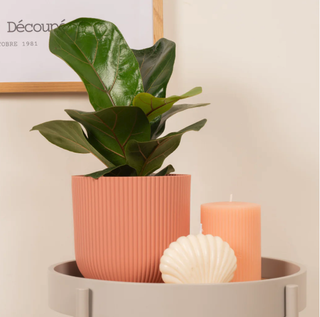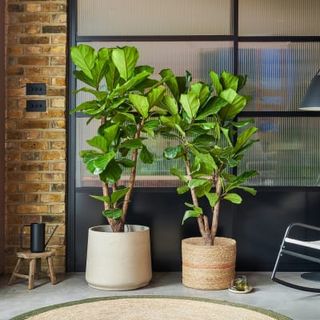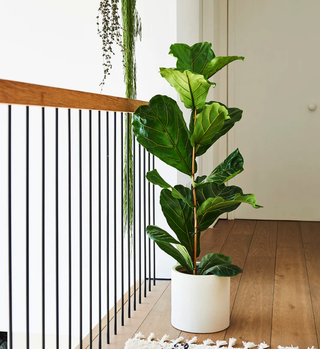How to care for Fiddle Leaf Fig to make the most of this swoon-worthy statement plant
Named for its abundant glossy fiddle-shaped leaves, this towering beauty brings a tropical flair to any interior scheme
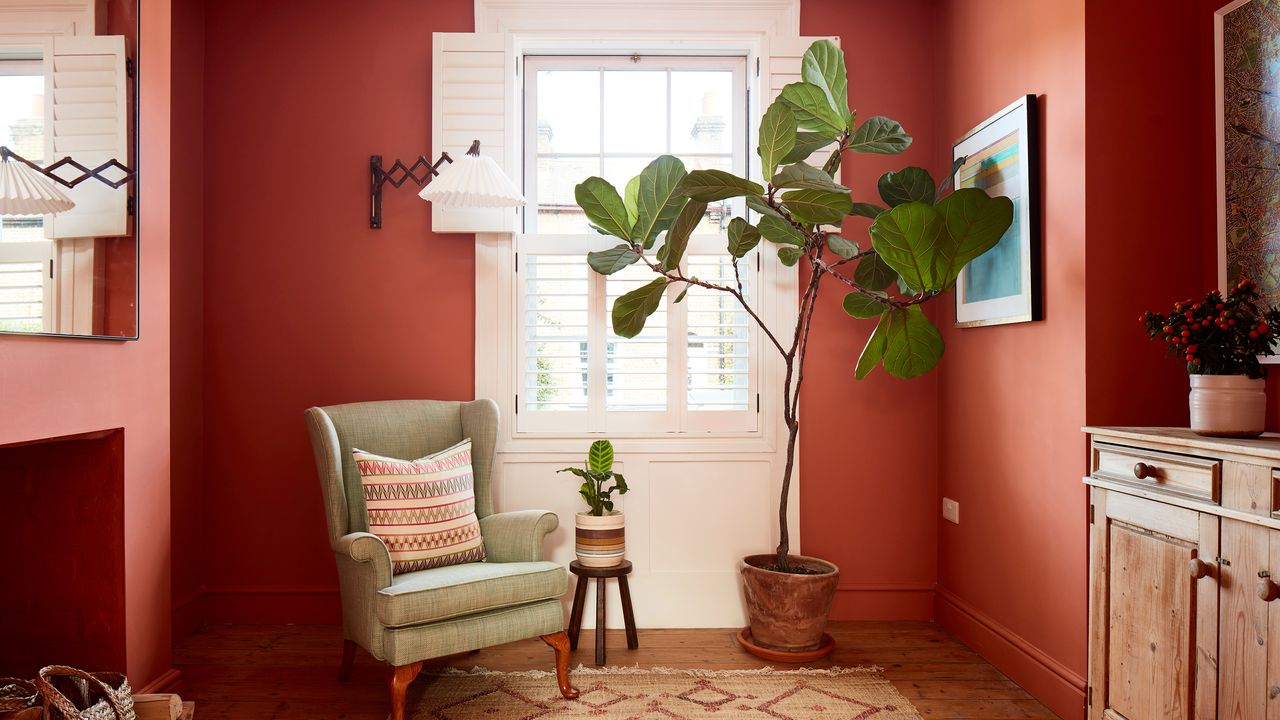

Reaching around two metres high, Fiddle Leaf Figs are a statement houseplant.
While it may have a reputation for being difficult, don't let not knowing how to care for Fiddle Leaf Figs put you off. One of the most stunning houseplant ideas, their towering stature makes them ideal for rooms that would benefit from a focal point and a little bit of natural beauty.
‘However, if you don’t have the space for a full-sized plant, there is a dwarf variety called ‘Bambino’ – which reaches 1 to 1.5 metres tall – and is a great alternative to full-height versions,’ says Angela Slater, gardening expert at Hayes Garden World.
As with most houseplants, over-loving them is often detrimental, so be cautious of overwatering. Also choosing a spot with the right light levels is essential for their wellbeing. Get these right and a Fiddle Leaf Fig will quickly become a much-loved addition to your home – after all, there's a reason that it's one of the most Instagrammed house plants.
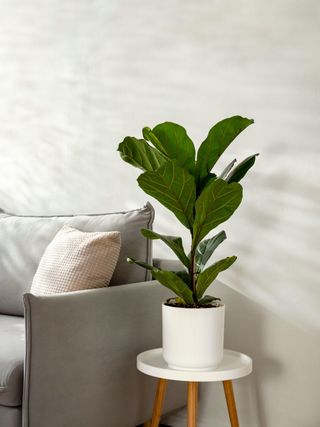
What you'll need
- Fiddle Leaf Fig
- Plastic pot with drainage holes – one size larger than the size of the plant bought
- Decorative pot without holes
- A liquid houseplant fertiliser, for example, Baby Bio Houseplant Fertiliser on Amazon
- A trowel
- Houseplant compost, such as Westland Houseplant Potting mix on Amazon
Where to buy Fiddle Leaf Figs
The best place to put a Fiddle Leaf Fig
Native to the tropical rainforests of West and Central Africa, Fiddle Leaf Figs thrive in warm, humid environments with a medium level of light.
‘Think carefully about where you place your plant as once in situ it shouldn’t be moved as this can cause shock and the leaves to drop,’ says garden expert Angela.
‘Fiddle Leaf Fig is an ideal plant for a centrally heated home as it needs at least 15C, even at night and in winter.’
Get the Ideal Home Newsletter
Sign up to our newsletter for style and decor inspiration, house makeovers, project advice and more.
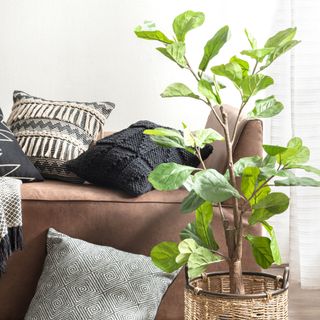
Positioning the Fiddle Leaf Fig in front of an east-facing window will ensure it receives ample indirect light. For a south-facing window, ensure the light is filtered through either a sheer curtain or blind, or perhaps a tree’s leaves. Avoid direct sunlight as this can cause the Fiddle Leaf Fig's leaves to burn.
‘If the room you want for your tree is north facing, then place it as close to the natural light source as possible,’ advises Kelly Dyer from Patch Plants.
While not one of the most low-maintenance houseplants, knowing the signs that your plant is struggling is vital in ensuring its well-being. Signs that the Fiddle Leaf Fig isn’t receiving enough light include leggy and weak growth.
‘A lack of light will also make the plant more susceptible to pests and diseases because they won’t be getting the resources required to grow at full capacity,’ explains Kelly.
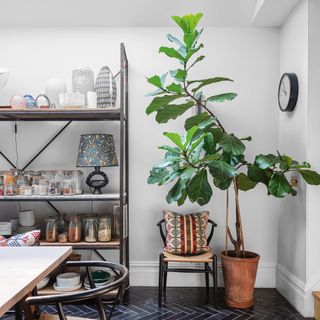
Watering a Fiddle Leaf Fig
‘Fiddle Leaf Figs prefer consistent but moderate watering,’ says Sonia Kainth from House of Kojo. ‘Ensure the pot you use has proper drainage to prevent water from lingering at the base. As Fiddle Leaf Figs have an intricate root system, overwatering can lead to root rot.’
When watering houseplants, it is common to thoroughly drench them, then let them thoroughly dry out before watering again. However, this is not the best approach for Fiddle Leaf Figs.
‘The drought-flooding approach to watering can cause the plant stress. You’re aiming for consistently, lightly moist soil,’ explains Kelly Dyer. ‘Don’t leave the soil to dry out so it contracts away from the insides of the pot as this will make it very difficult to draw up water again.’
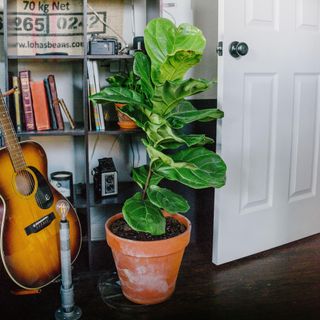
Water your Fiddle Leaf Figs by submerging the pot in a bucket of water. ‘Leave for a couple of minutes until bubbles have stopped rising, then remove the pot, drain and replace in its pot cover,’ says Angela. This method promotes healthier roots and reduces the risk of root rot – as the plant only takes what it needs.
For larger Ficus, Angela suggests standing the plant in a saucer of tepid water for about 30 minutes, then pour away any remaining water. If you forget – it's essential to take steps to save an overwatered plant to prevent lasting damage.
During the growing season – April to October, supplement the watering with a liquid houseplant fertiliser. Aim to feed every fortnight.
When to repot a Fiddle Leaf Fig
For a plant that can reach 20 meters in the wild, it will come as no surprise that the Fiddle Leaf Fig is a fast-growing houseplant.
‘If it is growing in an optimum position, it will need re-potting every 3 – 4 years. Look for roots appearing on the surface of the compost or the water running straight through the compost,’ says Angela.
Repotting a houseplant too early is one of the common repotting houseplant mistakes and should be avoided.
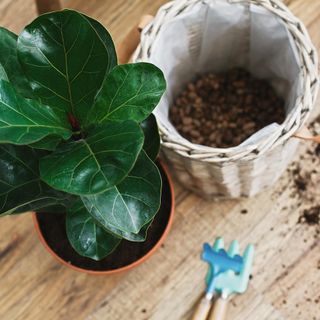
To repot, lift the plant out of its pot and remove as much of the old soil since it will be devoid of nutrients. If the plant was pot bound – there are more roots visible than soil – gently untangle the roots. This encourages the roots to grow into the new soil, anchoring the plant and helping to absorb water and nutrients.
Opt for a pot just one size larger than the previous one and fill it with a houseplant potting mix. ‘A well-draining potting mix is essential and I would recommend Grow Tropicals Simply Houseplant Mix as it provides the right blend of nutrients and components for the roots,' advises Sonia.
FAQs
Do Fiddle Leaf Fig need drainage holes?
Yes, drainage holes are essential for any houseplants as it prevents them from being overwatered and sitting in water which can lead to root rot. Overwatering is one of the biggest killers of houseplants – especially Fiddle Leaf Figs.
Do Fiddle Leaf Fig like to be moved?
No, fiddle leaf figs do not like to be moved. 'Fiddle leaf figs are sensitive when moved to a new environment, so be sure to minimise over-handling to avoid shock and leaf loss,' says Sonia Kainth.
What does an overwatered Fiddle Leaf Fig look like?
Dropping leaves is the first sign of overwatering. It can also be accompanied by the stems and roots becoming rotten. If your Fiddle Leaf Fig has been overwatered ensure it is not standing in any water, that the pot has good drainage holes and consider repotting with dry compost.

Holly is one of Ideal Home’s content editors. Starting her career in 2018 as a feature writer and sub-editor for Period Living magazine, she has continued this role also adding regular features for Country Homes & Interiors and the Ideal Home website to her roster. Holly has a passion for traditional and country-inspired interiors – especially kitchen design – and is happiest when exploring the countryside and hills of the Lake District. A keen gardener, she is a strong believer that you can never have too many houseplants.
-
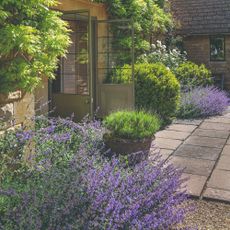 Can you revive woody lavender plants? Experts reveal the best way to do it and how to tell if your plants are past their best
Can you revive woody lavender plants? Experts reveal the best way to do it and how to tell if your plants are past their bestIf you don’t tend to lavender plants properly, things can get messy – fast!
By Kayleigh Dray
-
 How to clean a mattress gently – cleaning experts say all you need is a pan lid
How to clean a mattress gently – cleaning experts say all you need is a pan lidThe pan lid mattress cleaning hack is a gentle way to clean your mattress
By Kezia Reynolds
-
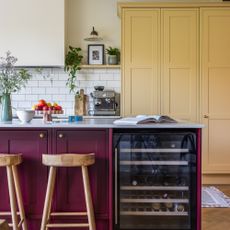 5 space-wasting items professional organisers never keep in kitchen cabinets
5 space-wasting items professional organisers never keep in kitchen cabinetsRemove these unnecessary items from your kitchen to create a space-savvy organisation system
By Marina Rabin
